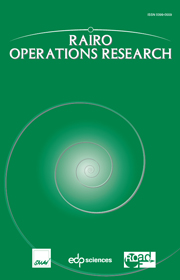Crossref Citations
This article has been cited by the following publications. This list is generated based on data provided by
Crossref.
Sung, Charles
and
Maravelias, Christos T.
2007.
Process Systems Engineering.
p.
269.
Minmin Qiu
Hongwei Ding
Jin Dong
Wei Wang
and
Changrui Ren
2008.
A myopic policy based simulation optimization framework in a general decentralized supply chain.
p.
2228.
Saharidis, Georgios K.D.
Kouikoglou, Vassilis S.
and
Dallery, Yves
2009.
Centralized and decentralized control polices for a two-stage stochastic supply chain with subcontracting.
International Journal of Production Economics,
Vol. 117,
Issue. 1,
p.
117.
Shah, Nikisha
Saharidis, Georgios K.D.
Jia, Zhenya
and
Ierapetritou, Marianthi G.
2009.
Centralized–decentralized optimization for refinery scheduling.
Computers & Chemical Engineering,
Vol. 33,
Issue. 12,
p.
2091.
Yan, Tingting
and
Dooley, Kevin J.
2010.
Entry timing in a secondary market: When to trade?.
International Journal of Production Economics,
Vol. 124,
Issue. 1,
p.
62.
Sung, Charles
and
Maravelias, Christos T.
2010.
Process Systems Engineering.
p.
269.
Raileanu, Silviu
Parlea, Mihai
Borangiu, Theodor
and
Stocklosa, Octavian
2012.
Service Orientation in Holonic and Multi-Agent Manufacturing Control.
Vol. 402,
Issue. ,
p.
265.
Ma, Peng
Wang, Haiyan
and
Shang, Jennifer
2013.
Supply chain channel strategies with quality and marketing effort-dependent demand.
International Journal of Production Economics,
Vol. 144,
Issue. 2,
p.
572.
Sahay, Nihar
and
Ierapetritou, Marianthi
2014.
Hybrid Simulation Based Optimization Framework for Centralized and Decentralized Supply Chains.
Industrial & Engineering Chemistry Research,
Vol. 53,
Issue. 10,
p.
3996.
Giri, B.C.
and
Maiti, T.
2014.
Profit improvement through retailer–Stackelberg in a multi-echelon supply chain of deteriorating product with price-sensitive demand.
Journal of Industrial and Production Engineering,
Vol. 31,
Issue. 4,
p.
187.
Kostarelou, Eftychia
and
Saharidis, Georgios K. D.
2014.
Encyclopedia of Business Analytics and Optimization.
p.
429.
Saharidis, Georgios K. D.
2014.
Encyclopedia of Business Analytics and Optimization.
p.
292.
Rauch, Erwin
Dallinger, Matthias
Dallasega, Patrick
and
Matt, Dominik T.
2015.
Sustainability in Manufacturing through Distributed Manufacturing Systems (DMS).
Procedia CIRP,
Vol. 29,
Issue. ,
p.
544.
Borangiu, Theodor
Răileanu, Silviu
Berger, Thierry
and
Trentesaux, Damien
2015.
Switching mode control strategy in manufacturing execution systems.
International Journal of Production Research,
Vol. 53,
Issue. 7,
p.
1950.
Jimenez, Jose-Fernando
Bekrar, Abdelghani
Zambrano-Rey, Gabriel
Trentesaux, Damien
and
Leitão, Paulo
2017.
Pollux: a dynamic hybrid control architecture for flexible job shop systems.
International Journal of Production Research,
Vol. 55,
Issue. 15,
p.
4229.
Nagarajan, Hari P.N.
Raman, Arvind Shankar
and
Haapala, Karl R.
2018.
A Sustainability Assessment Framework for Dynamic Cloud-based Distributed Manufacturing.
Procedia CIRP,
Vol. 69,
Issue. ,
p.
136.
Răileanu, Silviu
Anton, Florin Daniel
Borangiu, Theodor
and
Anton, Silvia
2018.
Service Orientation in Holonic and Multi-Agent Manufacturing.
Vol. 762,
Issue. ,
p.
201.
Mezgebe, Tsegay Tesfay
Bril El Haouzi, Hind
Demesure, Guillaume
and
Thomas, Andre
2018.
A Negotiation-based control approach for disturbed industrial context.
IFAC-PapersOnLine,
Vol. 51,
Issue. 11,
p.
1255.
Azzouz, Khaoula
Arif, Jabir
and
Benboubker, Mohamed Badr
2021.
Exploratory Study of the Role of Logistics Service Providers in Terms of Traceability in the Process of Outsourcing of Logistics’ Activities: Case of Moroccan LSP.
International Journal of Engineering Research in Africa,
Vol. 54,
Issue. ,
p.
187.
Arif, Jabir
and
Jawab, Fouad
2023.
Multicriteria Decision Making for the Selection of Agri-food Service Providers.
p.
33.


